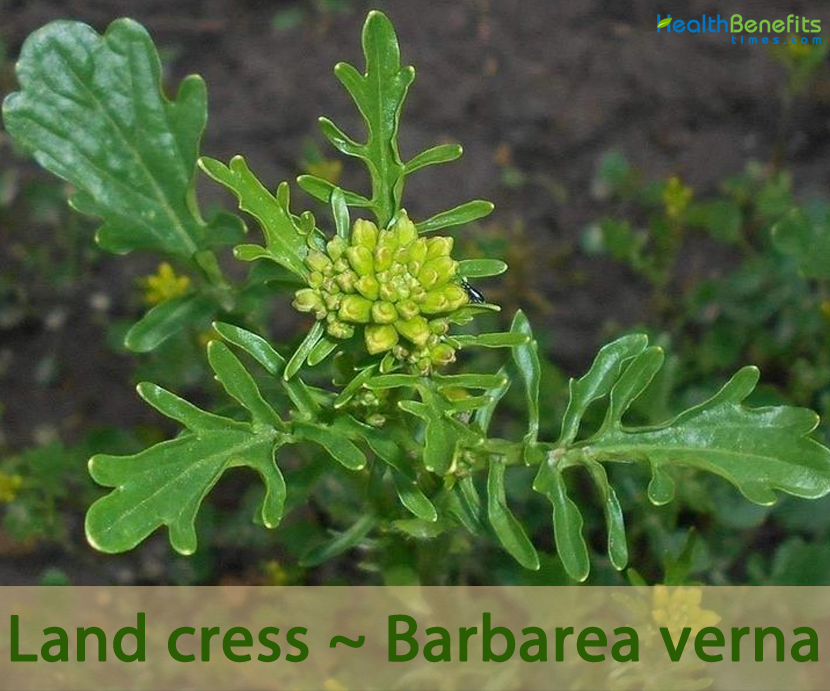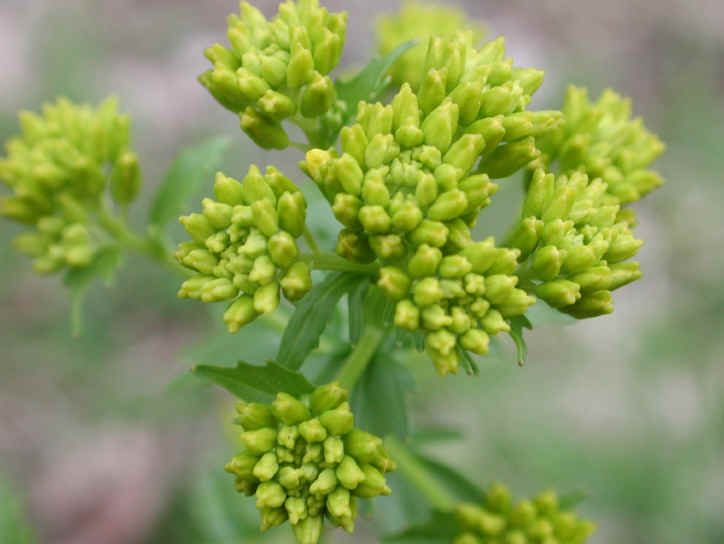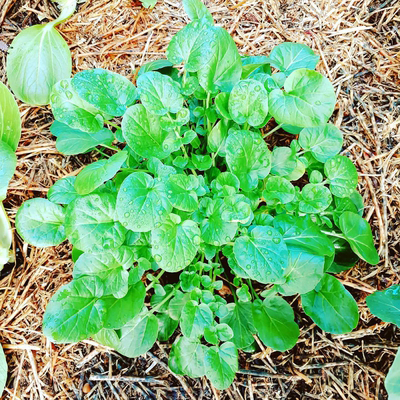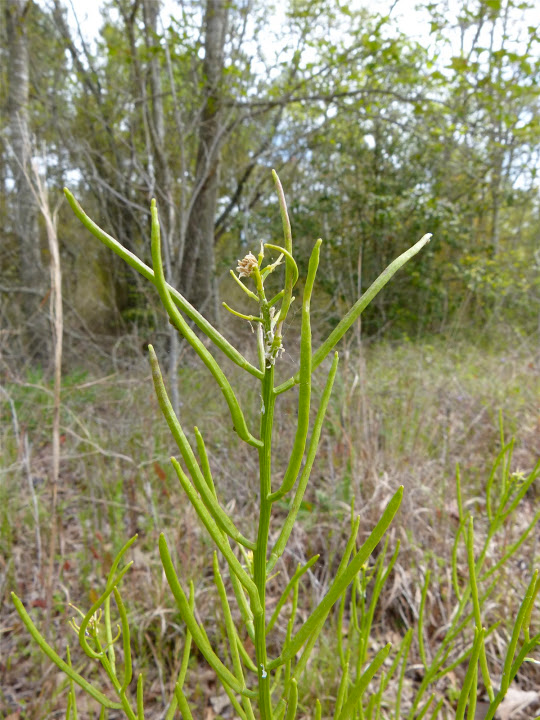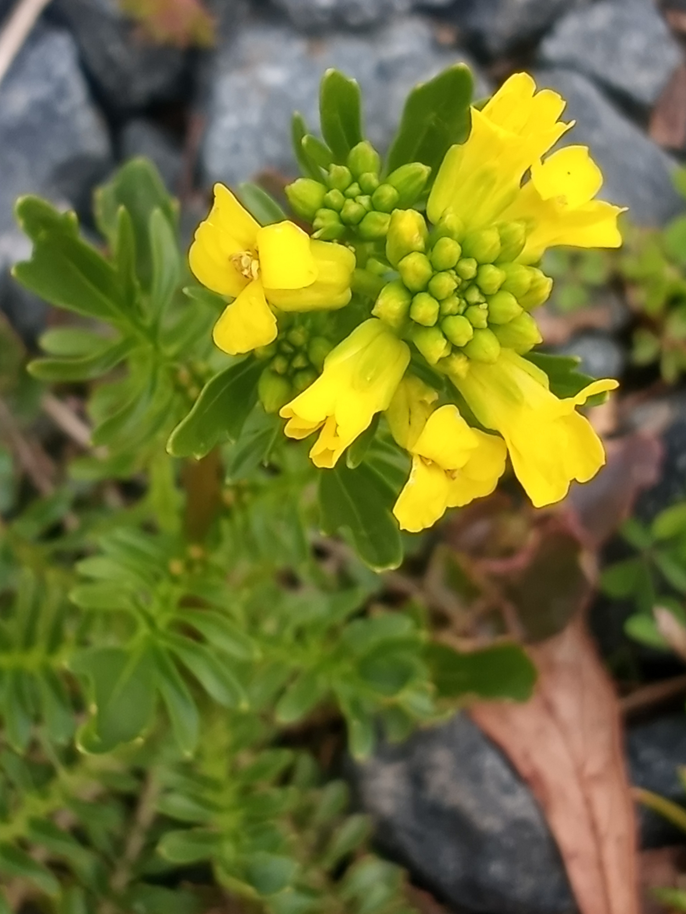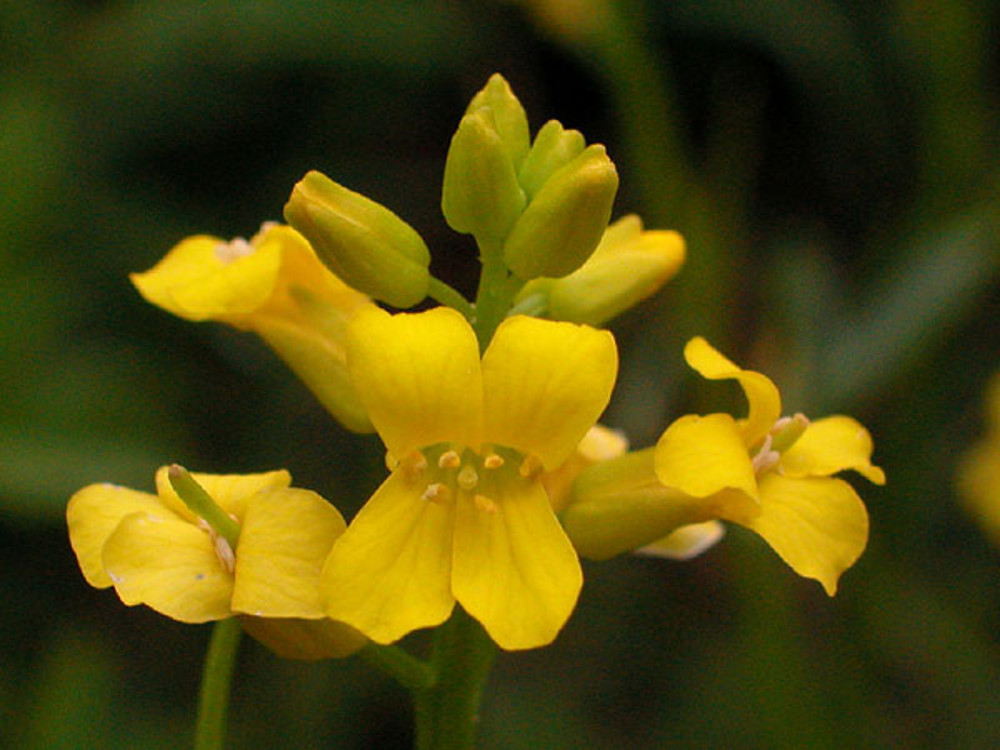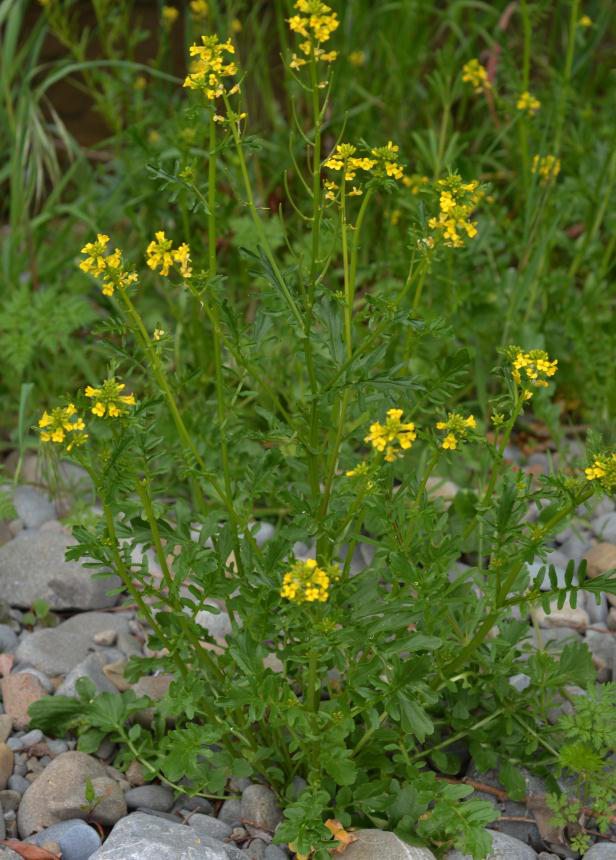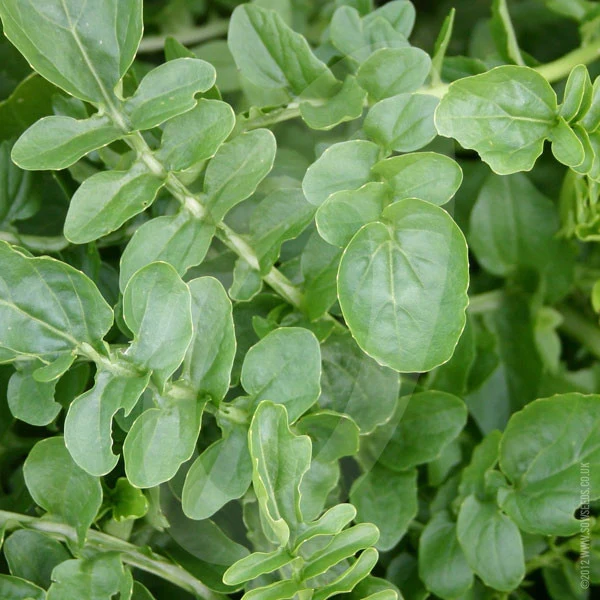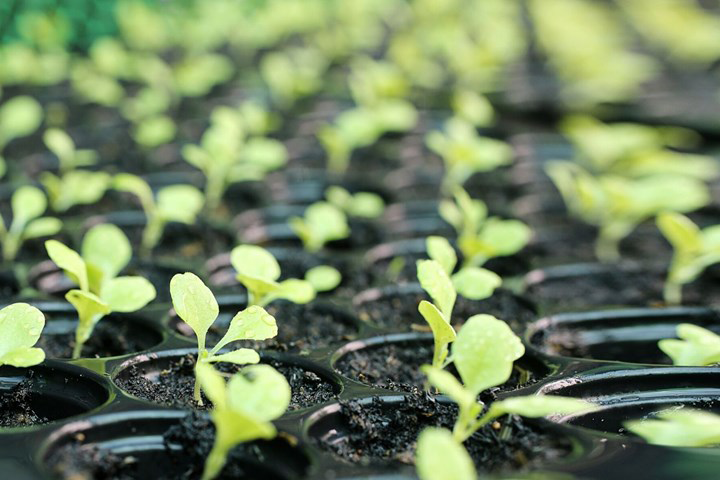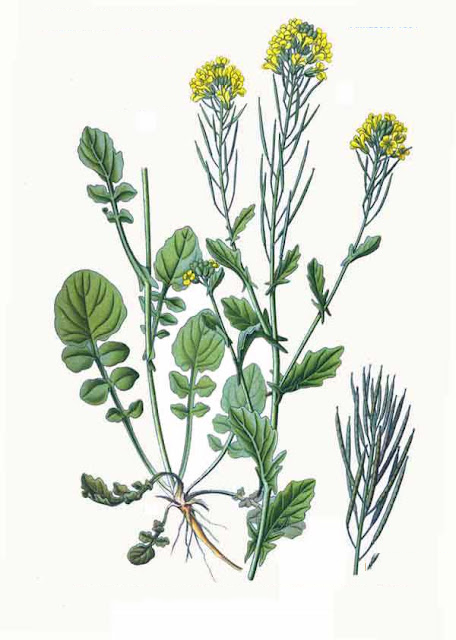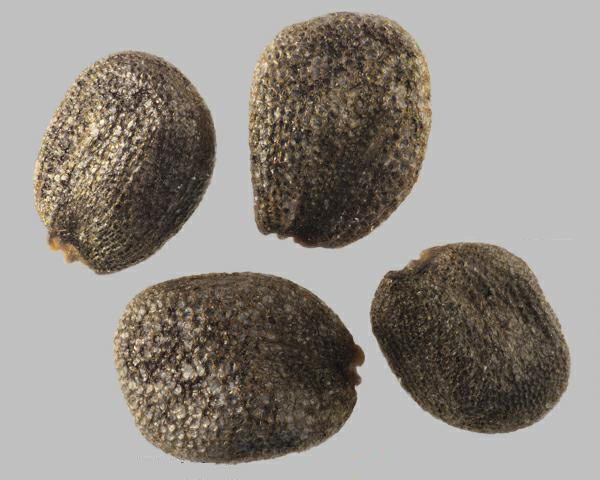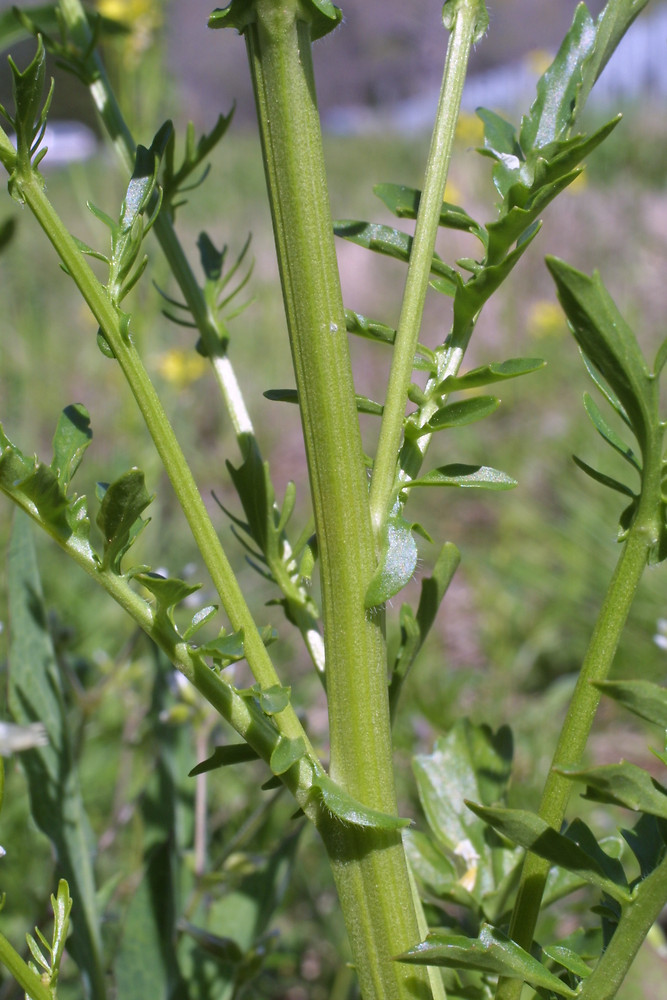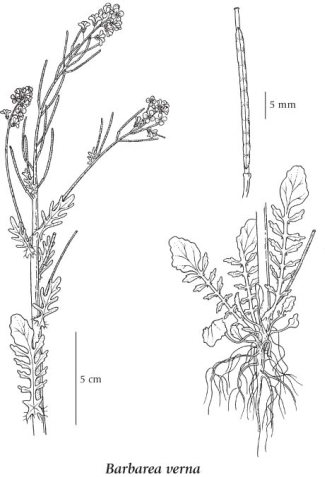| Land cress Quick Facts | |
|---|---|
| Name: | Land cress |
| Scientific Name: | Barbarea verna |
| Origin | Southern Europe and western Asia, and naturalized elsewhere |
| Shapes | Liberal siliqua of 40-70 mm long and 1.7-2 mm wide, slightly compressed, straight or curved, erect-ascending or sub-patent, glabrous; 0.7-1.5mm stylus |
| Taste | Sweet, Acrid |
| Health benefits | Support asthma, indigestion, constipation, sore throats, coughs, headaches, macular degeneration, heart health, clotting and strong bones |
| Name | Land cress |
|---|---|
| Scientific Name | Barbarea verna |
| Native | Southern Europe and western Asia, and naturalized elsewhere |
| Common Names | American cress, Belle Island cress, Early wintercress, Land cress, Scurvy-grass, American wintercress, Normandy cress, Common wintercress, Upland cress, Early yellowrocket, Early winter cress, American Winter Cress, American Winter-cress, American Land-Cress, Belle Isle cress, Early yellow rocket, Peppergrass, Winter Cress, Bermuda Cress, Early Winter-cress, Early Yellow-rocket, bank cress, black wood cress, scurvy cress, creasy greens, dryland cress, cassabully, bank cress, black wood cress |
| Name in Other Languages | Catalan: Herba de Santa Bàrbara, barbarea vernal Croatian: Barica ranocvjetna Danish: Langskulpet vinterkarse, Tidlig Vinterkarse Dutch: Vroeg barbarakruid English : American winter-cress, Early winter cress, Early yellow rocket, Land cress, Peppergrass, Upland cress, American cress, Belle Island cress, Normandy cress, Common wintercress, Scurvy-grass, American Land-Cress, Belle Isle cress, early yellowrocket, early winter cress, Belle Isle cress, Bermuda Cress Finnish: Krassikanankaali, Maakrassi French: Barbarée précoce, Barbarée printanière, Cresson de jardin, Cresson de terre, Herbe aux charpentiers, barbarée du printemps, German: Barbenkraut, Frühlingsbarbarakraut, Frühlings-Barbarakraut, Frühlings-Barbenkraut, Winterkresse, Frühes Barbarakraut Hungarian: Tavaszi borbálafű Irish: Treabhach earraigh Italian: Barbarea, Erba di Santa Barbara vernale Japanese: Kibanakuresu (キバナクレス) Manx: Burley traie Norwegian: Vårkarse Occitan: Cressoùn de terro Polish: Gorczycznik wiosenny Portuguese: Agrião-de-horta, Agrião-de-sequeiro, Agriao-rinchao, Agrião, Agrião-da-terra, Agrião-de-santa-bárbara, Agrião-dos-jardins, Erva-de-santa-bárbara, Mastruço-das-vinhas, urga Russian: Surepka vesennyaya (сурепка весенняя) Spanish: Berrillo, Berro mastuerzo, Hierba de Santa Bárbara, barbarea, barbarea vernal Swedish: Vårgyllen, Vinterkrasse Turkish: Er nicarotu Ukrainian: Suripytsya vesnyana (суріпиця весняна) Upper Sorbian: Zažna barmowka Welsh: Berwr Tir, Berwr-y-Gaeaf Cynnar |
| Plant Growth Habit | Biennial herbaceous |
| Growing Climates | Waste and cultivated ground, fields, limestone glades, rocky outcrops, railroad embankments, disturbed sites and roadsides |
| Soil | Prefers moist but well-drained sandy to loamy soil; however, it is adaptable and will do well in most soil types. A pH of between 6.0 and 6.8 will keep plants healthy and nourished |
| Plant Size | Up to 30 cm to 90 cm (about 12 inches to 36 inches) in height |
| Root | Taproot system |
| Leaf | Basal leaves arranged in a rosette, are 5 to 20 cm long. They appear dissected into 6 to 10 pairs of lobes; lateral ones are large, short, rounded, and sinuate or not while terminal ones are bigger, oval to sub-circular, slightly cordate at the base with sometimes, but rarely, small auriculate, spatulate basal lobes which seem petiolate. The stem leaves are alternate, simple, and also dissected into lobes. |
| Flowering season | May to July |
| Flower | In single and terminal racemes or more often in compound, reduced racemes in lower leaf axils; flower stalks stout, more than 1 mm thick, 2-3 mm long. Petals are bright yellow, broadly spoon-shaped, 6-8 mm long. Sepals are pale yellow-green, about 2 mm long. There are 6 stamens, 4 of which are cross shaped like petals and 2 shorter external ones. Such an androceo calls him tetradinamus. |
| Fruit Shape & Size | Liberal siliqua of 40-70 mm long and 1.7-2 mm wide, slightly compressed, straight or curved, erect-ascending or sub-patent, glabrous; 0.7-1.5mm stylus |
| Seed | Seeds are uni-seriati, oblong, alveolar-reticulate, 2.5 mm long and 1.2 mm wide and greyish-brown colored. |
| Taste | Sweet, Acrid |
| Plant Parts Used | Leaves, seed, oil |
| Propagation | By Seed or Division |
| Season | June to August |
| Other Facts |
|
| Precautions |
|
Plant Description
Land cress is an erect biennial herbaceous, slightly branched, glabrous plant that normally grows up to 30 cm to 90 cm (about 12 inches to 36 inches) in height. The plant is found growing in waste and cultivated ground, fields, limestone glades, rocky outcrops, railroad embankments, disturbed sites and roadsides. The plant Prefers moist but well-drained sandy to loamy soil; however, it is adaptable and will do well in most soil types. A pH of between 6.0 and 6.8 will keep plants healthy and nourished. Land cress can be grown easily in any garden. Like watercress, it loves water, but does not do well when partially submerged for long periods of time. This perennial needs full sun and frequent watering in any garden, unless nears a direct source of water.
Land cress, sometimes referred to as American cress, is a great substitute for watercress and can be a delicious addition to salads and since it is hardy, it can make it right through the winter with some protection and will provide healthy and tasty green leaves over a long period.
Leaves
Basal leaves arranged in a rosette, are 5 to 20 cm long. They appear dissected into 6 to 10 pairs of lobes; lateral ones are large, short, rounded, and sinuate or not while terminal ones are bigger, oval to sub-circular, slightly cordate at the base with sometimes, but rarely, small auriculate, spatulate basal lobes which seem petiolate. The stem leaves are alternate, simple, and also dissected into lobes. The lower stem leaves look dissected into 5 to 7 pairs of narrower lobes than those of the basal leaves. The upper leaves are sessile, dissected into narrow lobes and few in numbers.
Flower
In single and terminal racemes or more often in compound, reduced racemes in lower leaf axils; flower stalks stout, more than 1 mm thick, 2-3 mm long. Petals are bright yellow, broadly spoon-shaped, 6-8 mm long. Sepals are pale yellow-green, about 2 mm long. Flowering normally takes place in between May to July.
Fruit
Fertile flowers are followed by liberal siliqua of 40-70 mm long and 1.7-2 mm wide, slightly compressed, straight or curved, erect-ascending or sub-patent, glabrous; 0.7-1.5mm stylus. Seeds are uni-seriati, oblong, alveolar-reticulate, 2.5 mm long and 1.2 mm wide and greyish-brown colored.
Traditional uses and benefits of Land cress
- Deep green land cress is a very healthy plant to eat. It has twice the vitamin A as broccoli, and three times the vitamin C found in oranges.
- It also contains vitamins B and E, iron and calcium.
- Leaves were used as a source of nutrients and were used in folk medicine to help heal wounds.
- Seeds have been used for treating asthma, indigestion, constipation, sore throats, coughs, headaches, and as a good expectorant.
- Land Cress has hardly any carbs making it a wonderful weight loss food.
- Land Cress consists of lots of lutein which is important for preventing macular degeneration.
- Land Cress is a mild diuretic helping to get rid of excess water weight.
- Land Cress does not contain any sodium making it great for those on salt restricted diets.
- Land Cress is cholesterol free, making important for cardiovascular health.
- Land Cress contains lots of vitamin A, a powerful antioxidant, B’s vitamins for vitality and to prevent birth defect, vitamin C a powerful antioxidant, vitamin E for heart health, and vitamin K important for clotting. Also iron for anemia and calcium for strong bones.
Culinary Uses
- Young leaves can be consumed raw, cooked or used as a seasoning.
- A hot, spicy watercress flavor, they are delicious in salads.
- Leaves can be obtained throughout the year if autumn-sown plants are given a light protection in winter.
- Edible oil is obtained from the seed.
- Seed can be sprouted and added to salads etc.
- Land cress is considered a satisfactory substitute for watercress.
- It can be used in sandwiches, or salads, or cooked like spinach, or used in soup.
- Its young leaves have a hot spicy flavor that are frequently added to salads.
- It can be used in sandwiches, or salads, or cooked like spinach, or used in soup and fish.
- Land cress pairs well with meats such as fish, poultry, ham, and smoked turkey, avocado, apples, cucumbers, onions, garlic, and Greek yogurt.
- Land cress can be used both raw and cooked similarly to greens such as kale.
- Land cress is best suited for both raw and cooked applications such as steaming, boiling, or sautéing.
- When used fresh, the leaves can be tossed into salads, layered in sandwiches and wraps, mixed into pasta, or plated as a garnish.
- When cooked, the leaves are commonly mixed into soups, blended into sauces, or lightly sautéed and served alongside cooked meats.
- Land cress can be used both raw and cooked similarly to greens such as kale.
References:
https://www.itis.gov/servlet/SingleRpt/SingleRpt?search_topic=TSN&search_value=22743#null
https://pfaf.org/user/plant.aspx?latinname=Barbarea+verna
https://www.cabi.org/isc/datasheet/112660#totaxonomicTree
https://en.wikipedia.org/wiki/Barbarea_verna
http://www.theplantlist.org/tpl1.1/record/kew-2669710
https://indiabiodiversity.org/species/show/264161
https://portal.wiktrop.org/species/show/34?lang=en
https://gobotany.nativeplanttrust.org/species/barbarea/verna/
https://gd.eppo.int/taxon/BARVE
https://plants.usda.gov/home/plantProfile?symbol=BAVE


